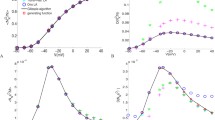Abstract
The involvement of atomic determinants in molecular models underlying ion-conducting proteins suggests a revisitation of classical concepts that are based on rate-theory models (e.g. ‘gating’ particles) and bulk solvation concepts. Here, we investigate possible effects of a quantum correlation regime within ion-conducting molecules (voltage gated ion channels) on the onset dynamics of propagating voltage pulses (action potentials, APs). In particular, we focus on the initiation characteristics of action potentials, (API). We model the classical onset parameters of the sodium current in the Hodgkin–Huxley equation as three similar but independent probabilistic mechanisms that can become quantum correlated. The underlying physics is general and can involve entanglement between various degrees of freedom underlying ion transition states or ‘gating states’ during conduction, for example, Na+ ions in different channel locations, or different coordination states of ions with atoms lining sub-regions of the protein (‘filter-states’). We find that the resulting semi-classical version of the Hodgkin–Huxley equation, incorporating entangled sodium channel system states, can either enhance or slow down the rise in membrane potentials at the time of signal initiation. As in principle a single sodium channel can drive the membrane to an AP threshold, we suggest that the observed effects of a semi quantum-classical signal description point to a self-amplification of Na+ channels and may be due to quantum interferences within the atomic environment of channel atoms. If inserted into canonical generators of AP signals, the suggested quantum term can further enhance signal onset-rapidness, an aspect that has recently been observed in real cortical neurons and that seems to be inevitable for the encoding of high-frequency input.


Similar content being viewed by others
References
Hodgkin AL, Huxley AF. A quantitative description of membrane current and its application to conduction and excitation in nerve. J Physiol. 1952;463:391.
Arcas BA, Adrienne L, Fairhall AL, Bialek W. Computation in a single neuron: Hodgkin and Huxley revisited. Neural Comput. 2003;15:1715.
Koch Ch, Bernander O. Axonal modelling. In: Arbib MA, editor. The handbook of brain theory and neural networks. Cambridge, MA: The MIT Press; 1998. p. 129.
Wang S, Liu F, Wang W, Yu Y. Impact of spatially correlated noise on neuronal firing. Phys Rev E. 2004;69:011909.
Kuyucak S, Andersen OS, Chung SH. Models of permeation in ion channels. Rep Prog Phys. 2001;64:1427–72.
Corry B. Understanding ion channel selectivity and gating and their role in cellular signaling. Mol Biol Sys. 2006;2:527–35.
Sasaki T, Matsuki N, Ikegaya Y. Action potential modulation during axonal conduction. Science. 2011;331:599–601.
Naundorf B, Wolf F, Volgushev M. Unique features of action potential initiation in cortical neurons. Nature. 2006;440:1060.
McCormick DA, Shu Y, Yu Y. Hodgkin and Huxley model—still standing ? Nature. 2007;445:E1.
Morals-Cabral JH, Zhou Y, MacKinnon R. Energetic optimization of ion conduction rate by K + selectivity filter. Nature. 2001;414:37.
Zhou Y, Morals-Cabral JH, Kaufman A, MacKinnon R. Chemistry of ion coordination and hydration revealed by a K+ channel-Fab complex at 2.0 Ao resolution. Nature. 2001;414:43.
Bernèche S, Roux B. Energetics of ion conduction through the K+ channel. Nature. 2001;414:73.
Berneche S, Roux B. A microscopic view of ion conduction through the K+ channel. PNAS. 2003;100:8644–8.
MacKinnon R. Potassium channels. FEBS Lett. 2003;555:62–5.
Shi N, Ye S, Alam A, Chen L, Jiang Y. Atomic structure of a Na+- and K+-conducting channel. Nature. 2006;440:570.
Bernroider G, Roy S, Quantum entanglement of K+ ions, multiple channel states and the role of noise in the brain. In: Stocks N, Abbott D, Morse RP, editors. Fluctuations and noise in biological, biophysical and biomedical systems III. SPIE; 2005: 5841, p. 205.
Roy S, Llinas R. Relevance of quantum mechanics on some aspects of ion channel function. CR Biol. 2009;332:517–22.
Summhammer J, Salari V, Bernroider G. A quantum-mechanical description of ion motion within the confining potentials of voltage gated ion channels. J Int Neurosci 2012 (in press).
Alle H, Roth A, Geiger JRP. Energy-efficient action potentials in hippocampal mossy fibers. Science. 2009;325:1405–8.
Costa-Krämer JL, Garcia N, Garcia-Mochales P, Serena PA, Marques MI, Correia A. Conductance quantization in nanowires formed between micro and macroscopic metallic electrodes. Phys Rev B. 1997;55:5416.
Cirac JI, Zoller P. A scalable quantum computer with ions in an array of microtraps. Nature. 2000;404:579–81.
Pachos J, Walther H. Quantum computation with trapped ions in an optical cavity. Phys Rev Lett. 2002;89:187903.
Zhu SL, Monroe C, Duan LM. Trapped ion quantum computation with transverse phonon modes. Phys Rev Lett. 2006;97:050505.
Pons M, Ahufinger V, Wunderlich Ch, Sanpera A, Braungardt S, SenDe A, Sen U, Lewenstein M. Trapped ion chain as a neural network: error resistant quantum computation. Phys Rev Lett. 2007;98:023003.
Kariev AM, Znamenskiy VS, Green ME. Quantum mechanical calculations of charge effects on gating the KcsA channel. Biochimica et Biophys Acta. 2007;1768:1218–29.
Vedral V. Quantifying entanglement in macroscopic systems. Nature. 2008;453:1004–7.
Author information
Authors and Affiliations
Corresponding author
Rights and permissions
About this article
Cite this article
Bernroider, G., Summhammer, J. Can Quantum Entanglement Between Ion Transition States Effect Action Potential Initiation?. Cogn Comput 4, 29–37 (2012). https://doi.org/10.1007/s12559-012-9126-7
Received:
Accepted:
Published:
Issue Date:
DOI: https://doi.org/10.1007/s12559-012-9126-7




